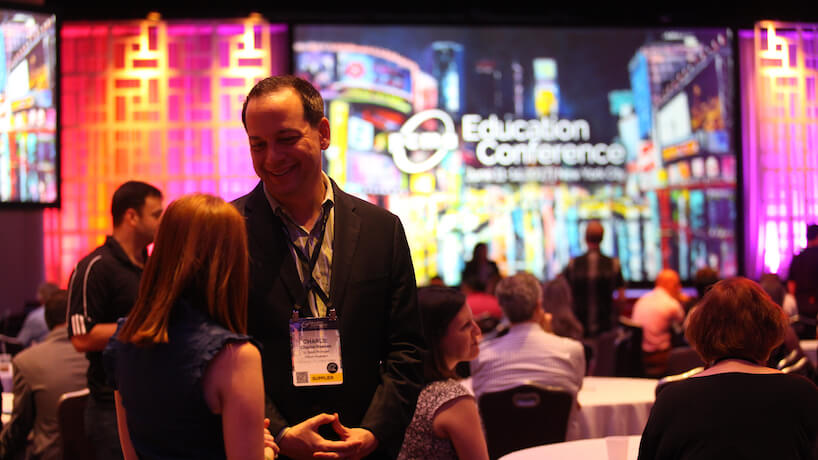PCMA prides itself on creating face-to-face programs that deliver hands-on, actionable strategies and tactics that participants can put to immediate use in planning their own events. Our 2017 Education Conference, held at the New York Marriott Marquis on June 11–14, was no exception. We captured dozens of takeaways from speakers and attendees alike — during sessions, on white boards set up throughout the open-space Connect zone, and at a dedicated Conference Takeaway Exchange. Here is a curated sampling of our community’s collective wisdom.
IMMERSIVE LEARNING EXPERIENCES
On Monday afternoon, we went off site to explore six different content themes at six uniquely New York City venues. Attendees were assigned to a venue based on their experience and learning goals.
Making Data Work for You / Microsoft Store
- Don’t just use technology because it’s new and cool — what’s your strategy?
- Think about the problem you want to solve for and then decide what technology will get you there.
- Know your participants and gamify your event with an experience that will appeal to them.
- Data shows what questions are being answered, and you can decide what’s being unanswered.
Show and Exhibit Design / Jacob K. Javits Convention Center
- Create experiences on the show floor!
- Creativity promotes ROI.
- Organize exhibitors by product category (think Home Depot).
- Focus on attendee experience first, then exhibitors.
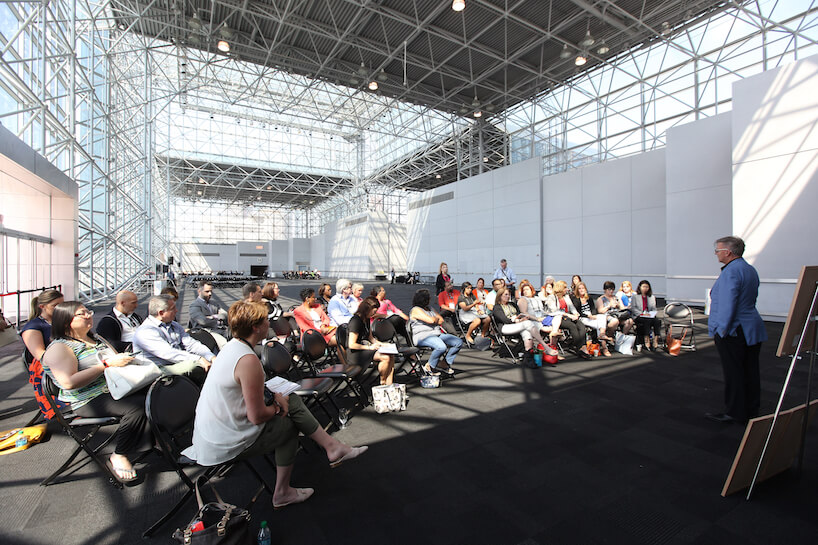
Production Design / Manhattan Center
- What story are you trying to tell?
- Good directors understand, pacing, timing, and flow.
- You should never have a job while on site at your event
- Instead of describing your design idea with words, use a collection of photos to help convey your idea properly.
Leadership and Performance / Tavern on the Green
- Own the way you are present.
- Use the senses to improve communication.
- Create a culture where people do not fear building off others’ ideas.
- You are only as effective as your ability to influence others!
Design Thinking / Convene
- Ask questions and listen.
- Power of stories and photos.
Imagination and Creativity / New Amsterdam Theatre
- Ensure all are on board with one clear vision.
- Use a common theme and voice throughout the entire event process (from sales and marketing to strategy and design).
- Storytelling is an essential strategy for the communication of new ideas.
- Foster an open communication policy — inform and include all members of your team (no matter where they are in the ranks) on your strategy, vision, and process to ensure success.
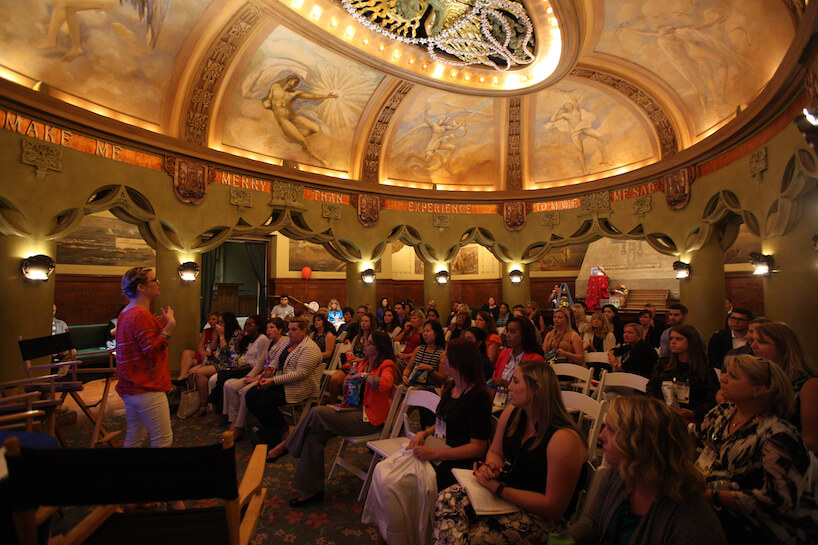
CROWDSOURCED SESSIONS
On Tuesday, we put attendees in the driver’s seat, inviting them to submit the biggest industry questions they wanted to discuss with fellow participants, then vote for the topics that most spoke to them. We turned the most thought-provoking questions into discussion topics for these crowdsourced sessions.
SESSION: Offer More Value to Your Sponsors Through Event Experiences
Moderator — Adib Hashem, Director of Partner Relations, PCMA
How can we enhance the attendee experience through sponsorship?
Ask your sponsors for their ideas, ask what they view as valuable, what their pain points are while keeping the end user in mind. What do you want your attendee to walk away with? How do you want to make them feel?
Five steps to get your partners on-boarded to an event-experience sponsorship:
- Map out the attendee journey and identify attendee pain points.
- Create a campaign brief and construct that promotes the partners by tier and considers the attendee experience.
- Set up measurement tools — e.g., beacon, social-media trends, etc.
- Reporting the campaign results back to stakeholders. Check out how we did with our recap video.
- Use your partners as ambassadors and make sure to provide them with the tools needed to promote the campaign, i.e., promo kit.
Analyze the impact of partner/sponsor relationships — both internally and for the partner/sponsor organizations:
- Identify your client’s goals and objectives upfront, then measure those goals and objectives post event.
- What are they seeking to accomplish?
- Ask clients: In order to be sitting here one year today, what needs to happen?
- Create an agenda sheet and go into the meeting prepared
- Create fulfillment reports.
- Immediately following the event, send a short, high-level written recap or short video on how you met their objectives.
- Followed by a lengthy, full report.
- Provide client with multiple fulfillment reports — beginning, mid, and end of year.
- Personalize the reports.
- Ask your client how they and their executives measure success.
- Different analysis for multiyear partners vs. year-to-year partners.
SESSION: Social Media Isn’t Just for Event Marketing
Moderator — Alex Plaxen, president and founder, Little Bird Told Media
Engagement:
- Explain benefits of using it.
- 10 minutes of social media makes people feel special and as good as a wedding day!
- Reply, like, re-tweet.
- Livestream with sponsors.
- Trade shows — livestream ahead of time, prepare.
- Facebook Live.
- Twitter — attendees searching will save.
- Instagram — if you want it to disappear
- Snapchat — 10-second videos.
- Facebook stories.
Content:
- Sharing.
- Live-streaming of speakers pitch your session.
- Speakers love it, fuller room.
- Age of users is diversifying.
- Use photos from speakers and tag them.
- In case you missed them.
- Email — you have to continue relationship.
- Tribalization.
SESSION: Redesigning Your Event for More Effective Engagement
Moderator — Kelly Peacy, CAE, CMP, Founder and CEO, Insight Event Strategy
Pain points:
- Introverts — also conservatives, older, etc.
- Dispersion — personal agendas.
- No interest in social.
- Venue/space not conducive, stuck in a space.
- Feeling too serious, lack of “buzz/vibe.”
- Speaker training/session design.
- C-level attention spans.
- Communication of value/newness.
Personalization:
- Questions allowed but not asked.
- Enable anonymity.
- Make web-based.
- Attendee webinars to communicate event news.
- Pre-engagement:
- Twitter chats – catered to each group.
- Preview webinars with speakers.
- Vote on event element — e.g., t-shirt design.
- Direct mail (also with gift).
- Pre-engagement:
Event elements that encourage engagement:
- Connect and communicate in the moment — and get it to last.
- Experience something together.
- Personal:
- Passion communities — especially good for introverts (bookworm, adventurer, etc.).
- Enabled by badge stickers @ PCMA EduCon.
- Business Breakthrough Incubator at PCMA EduCon — 3 teams hacking at a challenge that enables you to use brains within your community.
- Gathering space that’s visually interesting, a place to meet and have fun (“Connect” zone at EduCon).
- Education formats:
- Shake up with open formats (Q&A), crowdsourcing/vote, lecture followed by deep dive.
- Room sets, too! And places — i.e., EduCon’s Monday afternoon off-sites.
- Business-event strategists ask “What if?” and act with courage.
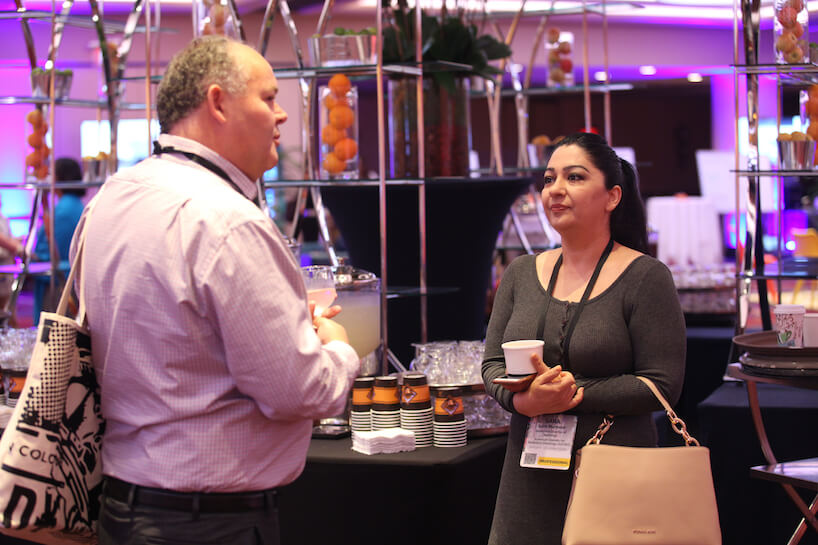
Experiences for introverts:
- Jigsaw puzzle — interaction at own speed.
- Coloring activity — OK to be quiet.
- On-your-own evenings.
- Smaller tables — sit with 4 instead of 10.
- Provide roles outside engagement — e.g., observer.
- Schedule whitespace (big chunks) and create quiet spots for it — also great for working!
SESSION: Combating Resistance to Change
Moderator — Eva Montgomery, Sales Director, CadmiumCD
Top pain points when trying to effect change:
- Getting others to recognize change is needed.
- Too much energy required to make change happen.
- Hard to communicate the value.
- Others are afraid of breaking the system.
- Afraid to even bring up ideas (perception the team won’t accept right off the bat).
- Pessimism — feeling that change won’t help.
- Too many decision makers to convince.
- Board, committee stuck in their ways, have been there a long time.
- Have budget, need support from others in the organization.
- Always done this way — why change?
- Different stakeholders are scared of failure.
- People in organization want change for sake of change — this isn’t good either.
- Fear: change can be risky + expensive.
- Getting buy-in from stakeholders.
- Maintaining persistence in presenting ideas.
- Feeling that I’m a meeting planner — I didn’t sign up to be a change agent.
Group focused on finding solutions to two main topics:
- Changing mindset:
- Consultant (outside resource).
- Collaborate/form relationships with people outside your area.
- Education surrounding the value of multiple perspectives.
- PCMA resources that address the “why.”
- Examples of similar organizations that have been successful.
- Relationship building.
- Budget — how to communicate value and get the investment needed for your idea:
- Value to stakeholders long-term plan.
- Back up with evidence/data, provide options for solutions.
- Find out why or why not — find real reason.
- Building community and helping organization, not just meeting
PRE-EVENT QUESTIONNAIRES + FEEDBACK IN CONNECT
Through pre-event questionnaires and numerous white boards spread through the Connect zone on site, we asked attendees to share their thoughts on a variety of major issues affecting business events, their career development, and more.
How can event professionals amplify engagement?
Conclusion: Listen to your audience and include them along the process.
- Crowdsourced topics.
- Provide multiple paths for attendees to ask questions and learn.
- Include the audience in the planning.
- Customize.
- Build events specifically around attendees.
- Ask attendees and then follow through with what they say.
- Diversity.
- Social-media videos.
- Content co-creation.
- Assign volunteer host to first-time attendee.
- Use lots of media platforms to allow communication. Listen and make connections!
- Listen to your attendees with both ears.
What makes you uncomfortable?
Conclusion: Most are uncomfortable with challenges they face with leadership and management.
- Lack of direction.
- Inefficiency (three times).
- The unknown.
- Taking risks.
- Unrealized expectations.
- Miscommunication (three times).
- Lack of information sharing.
- Walking in a room where I don’t know anyone!
- Mixed signals.
- Public speaking!
- Being lost.
- Not making a difference.
- Hiring new people.
- Lack of ROI.
- Lack of process.
- How to manage a bully boss.
- Not having supportive leadership.
- Telling my boss how to do his/her job.
- Experiencing something new for the first time.
- Bigotry.
- Leadership without communicating vision.
- People that won’t use technology.
- Hidden agendas.
- Misogyny.
Year 2020 leadership: What skillset will be most important?
Conclusion: People skills like communication and collaboration are seen as being as valuable as data analysis.
- Big data.
- Data analysis (4 times).
- Critical thinking.
- Creative leadership.
- Ability to achieve consensus.
- Building relationships.
- Open mindedness.
- Agility.
- Collaboration.
- Effective management skills.
- Communication.
- Innovation (3 times).
- Ability to adopt quickly to changing conditions.
- Flexibility.
- Creative planning.
- Effective listening.
- Creating context.
What type of experience do you want from the PCMA Education Conference?
- Smaller, more intimate. I would pay more for a more navigable event.
- More bot joys!
- Time to work out!!
- Another off-site session.
- Love the smaller audience here vs. Convening Leaders = more interactive, more opportunity to build connections. Don’t let this get too big. Leader/strategy focused to continue to elevate our industry.
- First-time attendee session
PCMA EDUCATION FOUNDATION TECHNOLOGY RESEARCH
We invited attendees to comment on several key findings from new PCMA Education Foundation research into technology use at meetings and events — leaving their comments on easels set up in the Convene section of the Connect zone.
Millennial attendees are less likely to use social media during networking or social events. Does this surprise you? What might be the reasons for this?
- Already have pre-established accounts that may not be set up for professional use.
- Less likely to have peers who would engage with the content (in their network).
Larger, better-funded organizations are using technology in a more comprehensive fashion than smaller organizations to improve attendee engagement. How can smaller organizations keep up? What are some less expensive and more manageable strategies they can use?
- Feathr.
- Social media.
As event organizers use tracking technology more often, how will this impact how events are produced and planned?
- We can increase the amount of meetings/exhibits that interest them.
- Can plan more accurately.
Event organizers anticipate using artificial intelligence (AI) more often in the future. What will be the most common use of AI to improve the attendee experience?
- Self check-in at registration.
CONFERENCE TAKEAWAY EXCHANGE
The final morning of the Education Conference, we presented the Conference Takeaway Exchange, where a core group of participants traded insights on what they learned from the program and will be implementing when they get back to the office.
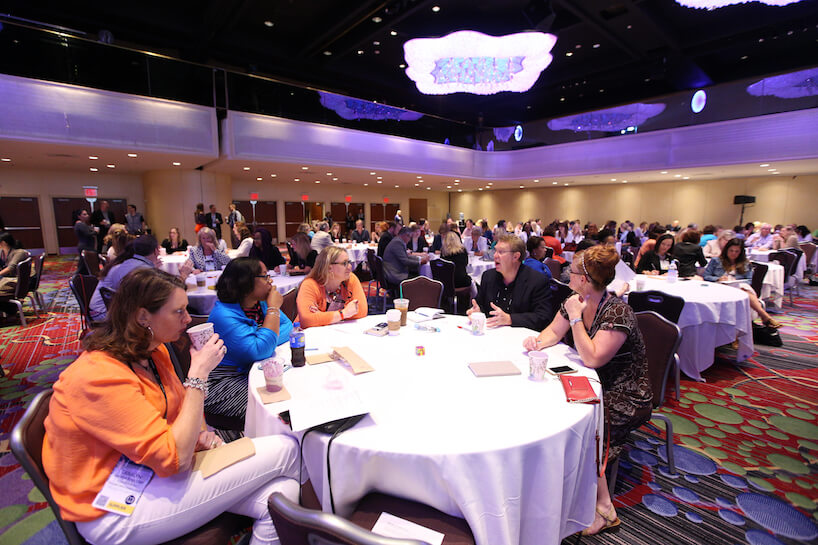
The single most important thing I wanted to get out of the conference was:
- Looking for new ideas.
- Taking advantage of the strong education offerings.
- Looking for new best practices.
- Looking for ways to redesign our current meeting.
- Networking at EduCon because of its size
When I get back I plan to:
- See if I have off-site educational opportunities like the breakouts we did.
- Explore unconventional styles for breakout-room sets (for meal formats or reception-style lunch).
- Brainstorm ways to take my attendees out to experience the location, like PCMA enabled us to experience NYC, instead of just bringing the destination into the hotel.
- Think about ways to make our sessions more interactive.
- Focus on first-time attendees at our events.
- Research how to take our attendees off-property for sessions.
- Implement the disruption ideas within our team.
- Perfect my pitch for a specific new learning format so that it may actually get approved.
- Set measurement benchmarks to see where I am and get goals to improve.
- Work with our team on our pitch.
- Ask questions in a different way.
- Curate an off-site education plan tailored to my organization’s conference attendees and incorporating a large sponsor.
- Take our dine-around to a new level with sponsorship options (idea from colleague in a session).
- Explore options of demo block for vendors.
- Take the Business Breakthrough Incubator idea to a pre-con event for invitees to solve a challenge for my organization (i.e., membership engagement).
- Continue to explore my failures and how I respond to them, and continue to grow based on the tools gained in sessions.
- Share the Business Breakthrough Incubator concept as an internal training idea to help our team practice preparing a business plan and presenting their pitch.
- Facilitate a strategy-development session with the New England Chapter, but also for a new business team.
- Continue to approach my work with disruptive thinking. It has provided significant growth and acknowledgment of that value is powerful and motivating.
- Take next steps to get an MBA. I realized the sessions and parts of the event I found most engaging were business professors delivering content or the strategy/design observations.

